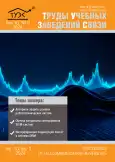Динамические туманные вычисления и бессерверная архитектура: на пути к зеленым ИКТ
- Авторы: Волков А.Н.1
-
Учреждения:
- Санкт-Петербургский государственный университет телекоммуникаций им. проф. М. А. Бонч-Бруевича
- Выпуск: Том 10, № 3 (2024)
- Страницы: 24-34
- Раздел: ЭЛЕКТРОНИКА, ФОТОНИКА, ПРИБОРОСТРОЕНИЕ И СВЯЗЬ
- URL: https://journals.rcsi.science/1813-324X/article/view/259509
- EDN: https://elibrary.ru/QOELMJ
- ID: 259509
Цитировать
Полный текст
Аннотация
Об авторах
А. Н. Волков
Санкт-Петербургский государственный университет телекоммуникаций им. проф. М. А. Бонч-Бруевича
Email: artem.nv@sut.ru
ORCID iD: 0009-0002-4296-1822
SPIN-код: 1311-9824
Список литературы
- Market Overview // Straits research. URL: https://straitsresearch.com/report/data-center-equipment-market (дата обращения 31.05.2024)
- Колбанёв М.О., Палкин И.И., Пойманова Е.Д., Татарникова Т.М. Пути создания зеленых информационных технологий // Гидрометеорология и экология. 2021. № 62. С. 127‒138. doi: 10.33933/2074-2762-2021-62-127-138. EDN:OEJEMQ
- Manner J. Black software ‒ the energy unsustainability of software systems in the 21st century // Oxford Open Energy. 2023. Vol. 2. doi: 10.1093/ooenergy/oiac011
- Alloghani M.A. Architecting Green Artificial Intelligence Products: Recommendations for Sustainable AI Software Development and Evaluation // Artificial Intelligence and Sustainability. Signals and Communication. Cham: Springer, 2024. PP. 65–86. doi: 10.1007/978-3-031-45214-7_4
- Schwartz R., Dodge J., Smith N.A., Etzioni O. Green AI // Communications of the ACM. 2020. Vol. 63. Iss. 12. PP. 54–63. doi: 10.1145/3381831
- Li Y., Zhu Z., Guan Y., Kang Y. Research on the structural features and influence mechanism of the green ICT transnational cooperation network // Economic Analysis and Policy. 2022. Vol. 75. PP. 734–749. doi: 10.1016/j.eap.2022.07.003
- Кричевский Г.Е. Экология и «Зеленые технологии». Как сдержать превращение биосферы в техносферу? // НБИКС ‒ Наука. Технологии. 2019. Т. 3. № 8. C. 22‒26.
- Волков А.Н. Туманность в перспективных сетях связи для услуг телеприсутствия // Электросвязь. 2024. № 4. С. 50‒56.
- Волков А.Н. Стабильность кластера в динамических туманных вычислениях // Электросвязь. 2024. № 6. С. 8‒16.
- Марочкина А.В. Моделирование и кластеризация трехмерной сети интернета вещей с применением метода оценки фрактальной размерности // Электросвязь. 2023. № 6. С. 60‒66. doi: 10.34832/ELSV.2023.43.6.008. EDN:ZBNQKI
- Марочкина А.В. Выбор головных узлов кластеров в трехмерных сетях Интернета вещей высокой плотности // Электросвязь. 2023. № 7. С. 26‒32. doi: 10.34832/ELSV.2023.44.7.004. EDN:MKMNQZ
Дополнительные файлы






